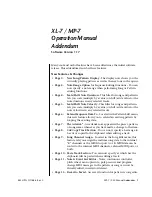
by Honeywell
Setup
Before using the AutoRAE 2 Cradle to bump test or calibrate, make sure the AutoRAE 2 Cradle and (if one is used)
the AutoRAE 2 Controller is running the latest firmware. Also, follow the instructions in the AutoRAE 2 User’s
Guide for programming the gas configurations.
Important!
Each calibration gas cylinder must have a demand-flow regulator.
Connections
Important!
Always check that the gas configuration and the type/concentration of the calibration gases connected to
the AutoRAE 2 Cradle match before you begin any bump test or calibration. Make sure there is enough gas in the
cylinder(s). Set the RTC (real-time clock) date and time on the Cradle via ProRAE Studio II before first use.
Placing An Instrument In The Cradle
Important!
If the Cradle is for a ToxiRAE Pro-family instrument, make sure the correct calibration adapter is in place.
1.
Make sure the filter on the instrument is not dirty or clogged (MiniRAE 3000, ppbRAE 3000, UltraRAE 3000, and
MiniRAE Lite must be equipped with Quick Connectors and have their inlet probes removed).
2.
Make sure the instrument is turned off or in AutoRAE 2 Mode.
3.
Place the instrument into the cradle face-down, making check that it is aligned correctly with the contacts on the
AutoRAE 2 Cradle’s charging port.
4.
Press in on the capture mechanism to lock the instrument in place.
Exhaust
Calibration
Gas
Cylinder 1
Calibration
Gas
Cylinder 2
Press filter onto
receptacle at
end of Cradle
Plug barrel from AC adapter into
jack, then AC Adapter to AC
power source
Install left and right end caps
Connect gas cylinders with gas inlets
The ToxiRAE Pro Cradle
requires an adapter to be
inserted in the capture
mechanism. ToxiRAE Pro
and ToxiRAE Pro LEL (L)
and ToxiRAE Pro PID (R).
MultiRAE
ToxiRAE Pro
QRAE 3
Handheld PID
MicroRAE
UltraRAE 3000 or ppbRAE 3000 only:
Use an Active
Carbon Filter
for VOC filtering
!






















